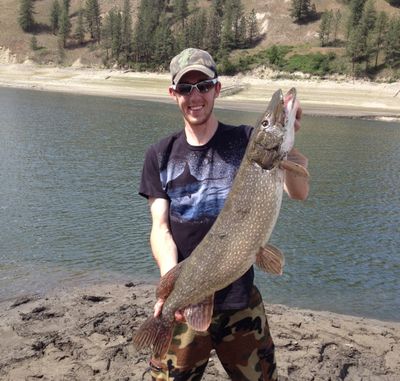Landers: Fish managers plan attack on northern pike in Roosevelt

Northern pike have bared their teeth in Lake Roosevelt this year, bringing to mind the early 2000s, when the non-native predators first showed up in significant numbers in the Pend Oreille River.
Fishermen have been catching some whoppers near Kettle Falls.
“While jigging for walleyes near the mouth of the Colville, I caught a 15-pounder ,” said Sean Hansen of Vancouver. “My friend who lives at Kettle Falls has caught more than 20 in the past couple of months.
“We were getting bit off last year while fishing for walleye and smallmouths and we didn’t put it together until I had a pike follow my lure all the way in.”
But pike enthusiasts shouldn’t get their hopes up that the fishery will boom in the Columbia River reservoir behind Grand Coulee Dam as it did in the late 2000s behind Box Canyon Dam:
• The habitat isn’t the same.
• State and tribal fish managers already are making plans to suppress the pike with gillnets.
Funding is being sought and northern pike in the Columbia Basin are on the agenda for the June 9 Northwest Power and Conservation Council meeting in Coeur d’Alene.
“We’re not going to mess around with these things,” said Chris Donley, Washington Department of Fish and Wildlife inland fisheries manager. “This is about salmon recovery and other complexities down the river we want to avoid.”
“There’s been some concern that fish would come down into the Columbia from the Pend Oreille,” says Chuck Lee, the department fisheries biologist who’s assessing the situation.
“A 2006 survey in the Pend Oreille estimated about 400 adult northern pike in Box Canyon Reservoir,” he said, noting that the fish apparently came downstream from illegal introductions in Montana. “A 2010 survey indicated the population had boomed to about 5,500 fish.
“The expansion happened very quickly. The Pend Oreille River has a lot of sloughy vegetated shallows that support spawning.”
The state and Kalispell Tribe began using gillnets to suppress northern pike. From 2012 to 2014 they removed 16,000 pike from the reservoir downstream from Newport.
Suppression netting this spring removed only 751 pike compared with about 5,700 netted in 2012 and about 6,000 in 2013
“Mechanical suppression on a large scale is very feasible,” said tribal biologist Jason Conner, who helps manage the netting program.
But the effort hasn’t prevented some pike from moving downstream, into Canada and the Columbia.
Two years ago, British Columbia biologists started identifying pike below Keenleyside Dam. A 2014 survey in that area estimated a population of 500-2,700 northern pike.
“Based on the concern for predation on sturgeon and native salmonids, they began pike suppression in 2014 and removed about 18 percent of the population,” Lee said. “They determined the pike diet was 76 percent salmonids – 44 percent mountain whitefish and 17 percent rainbow trout, plus kokanee.”
Canada plans to continue pike suppression in the Columbia, he said.
Washington and the area tribes plan to follow suit.
Pike first started showing in Lake Roosevelt fall walleye index study gillnetting in 2011, Lee said. “We caught only one in the Marcus area that year and up to seven last year, all just north of Kettle Falls, but the survey doesn’t extend into the Kettle River.
“We’ve had limited reports of pike harvest from anglers in the past, but never identified one in the creel until this year,” he added, noting that anglers have showed them to creel checkers at the Kettle Falls boat ramp.
The fish have been in the 24- to 36-inch range, caught roughly from the mouth of the Kettle River to the mouth of the Colville.
Fish managers plan to do a pike netting survey starting this spring. Work on the Pend Oreille River has shown the best time to target pike is during May as they’re spawning.
But Lake Roosevelt is still in a drawdown and waters aren’t flooding most of the shallows where pike would prefer to spawn.
Fish managers are waiting for the dam to refill, which won’t start until around June 1, the U.S. Bureau of Reclamation says.
“The pike larvae need vegetation to cling to, and Lake Roosevelt doesn’t have much of that right now,” Lee said. “We’re holding off, probably until early June.
“Peak spawning usually happens in March and April. In Lake Roosevelt, that may not happen.”
Meantime, DNA testing is underway to determine if the pike showing up in Lake Roosevelt originated in the Pend Oreille River, in Canada waters or in the Kettle River Arm.
“That will give us an idea if pike are spawning in the Kettle,” Lee said.
He noted that northern pike have been found in Lake Spokane for years, but no pike spawning has been documented in the reservoir behind Long Lake Dam.
“That indicates those fish are coming down from Lake Coeur d’Alene,” he said. “We’re mostly concerned where pike might be spawning.
“There’s a lot of work that’s been done on redband trout focused on the Kettle River and tributaries of the Upper Columbia, as well as the sturgeon,” he said.
“We need to get a handle on the pike.”
Meanwhile, Sean Hansen and his Kettle Falls friend, Chris St. Clair, are enjoying their occasional run-ins with the toothy large predators.
“They’ve hit spinners, spoons, crankbaits, plastics – just about everything,” Hansen said. “I caught the big one on a jig. It was 15 pounds, full of eggs and had an 18-inch northern pike minnow in its stomach. The pike fillets were delicious.”
“We would like it if anglers would catch them and kill them,” Donley said. “We don’t need another predator in Lake Roosevelt. It’s got plenty now.”
Contact Rich Landers at (509) 459-5508 or by email at richl@spokesman.com.